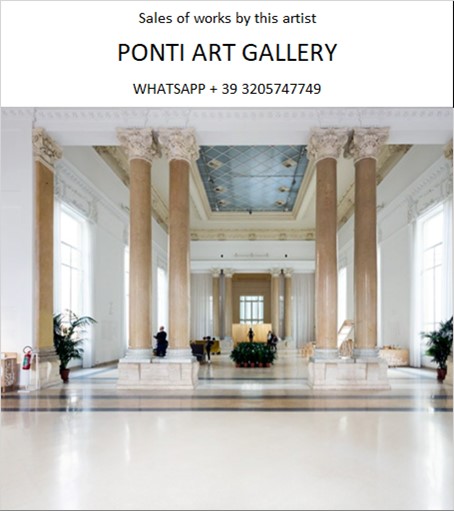Ponti Art Gallery is interested in buying and selling works
of art by this artist.

Francis Newton-Souza Biography
Francis Newton Souza, born on April 12, 1924, in Saligao, Goa, was a pioneering figure in the world of modern Indian art. His life, marked by rebellion, innovation, and a relentless pursuit of artistic expression, spanned several continents and numerous artistic movements, making him one of the most influential and complex figures in Indian art history.
Souza's early life was steeped in the cultural and religious milieu of Portuguese-controlled Goa. Brought up in a strict Roman Catholic family, he was exposed to the duality of sin and sensuality from a young age, a theme that would deeply influence his later work. Despite the early loss of his father and sister, Souza's mother played a pivotal role in his upbringing, encouraging his artistic inclinations despite the challenges they faced.
His education began at St. Xavier's High School in Bombay, where his rebellious nature first came to the fore. Souza was expelled for drawing obscene graffiti in the school's restrooms, an act that foreshadowed his lifelong penchant for challenging societal norms. Undeterred, he enrolled at the Sir J.J. School of Art in Bombay, only to be expelled again for his participation in the anti-British Quit India movement. This period of political activism marked the beginning of Souza's engagement with broader social issues, which would later permeate his art.
In 1947, amidst the backdrop of India's newly gained independence, Souza co-founded the Progressive Artists' Group (PAG) with fellow artists like Syed Haider Raza and M.F. Husain. The group sought to break free from the conservative confines of pre-independence Indian art, embracing instead the influences of Post-Impressionism, Cubism, and Expressionism. This was a pivotal moment in Indian art, signaling a departure from traditional forms and themes towards a more global, modernist approach.
Souza's work during this period was characterized by a bold, expressionistic style, marked by aggressive lines and a vibrant palette. His subjects ranged from still lifes and landscapes to erotic nudes and religious themes, often depicting the latter with a critical, sometimes blasphemous eye. This irreverence towards established religious and societal norms frequently courted controversy, leading to several of his exhibitions being attacked or censored.
In 1949, seeking broader horizons and perhaps escaping the controversies that dogged him in India, Souza moved to London. The initial years were marked by struggle, as he worked various jobs while trying to establish himself as an artist. His breakthrough came with the publication of his autobiographical essay, "Nirvana of a Maggot," in Stephen Spender's Encounter magazine, followed by a successful solo exhibition at Gallery One in 1955. This period marked the beginning of Souza's international acclaim, with his work being recognized for its unique blend of Indian themes with European modernist techniques.
Souza's time in London was followed by a move to New York in 1967, where he continued to explore and expand his artistic repertoire. Despite facing challenges in the American art market, Souza remained prolific, experimenting with new forms and techniques. His work from this period reflects a deep engagement with his own identity as an Indian artist in the Western world, grappling with themes of displacement, alienation, and the search for spiritual and artistic truth.
Throughout his career, Souza's work was marked by a relentless questioning of the status quo, whether in terms of artistic form, religious dogma, or societal norms. His paintings, often disturbing and provocative, are a testament to his belief in the power of art to challenge, provoke, and ultimately transcend the limitations of its time.
Souza's legacy is complex and multifaceted. On one hand, he is celebrated for his pioneering role in the development of modern Indian art and his contributions to the global art scene. On the other, his life and work continue to provoke debate and introspection, reflecting the contradictions and challenges of a man who was at once a rebel, an innovator, and a visionary.
Francis Newton Souza passed away on March 28, 2002, in Mumbai, leaving behind a body of work that continues to inspire and challenge viewers around the world. His paintings are held in prestigious collections and museums, testament to his enduring influence on the art world. As we continue to explore and reinterpret his work, Souza's legacy as a pivotal figure in the history of modern Indian art remains unassailable.
Francis Newton-Souza Quotes
and Sales of Works
Ponti Art Gallery selects and deals with paintings by the
artist. Upon request, we provide free estimates and
evaluations, communicate prices, quotations, and current
market values.
If you are interested in BUYING or SELLING works by the
artist, contact us immediately.
If you wish to sell or receive an evaluation of the
works:
Send us a frontal photo of the painting, one of the back,
and one of the signature. Also, indicate the dimensions of
the work. Inform us about the purchase origin of the work
and any kind of available documentation (purchase
receipts, certificates of authenticity, publications). One
of our operators will respond to you on the same day. We
guarantee maximum confidentiality and extreme
professionalism.
If you wish to purchase works by the painter: Contact us
and let us know your request. We will inform you about the
available works. We also offer the possibility to
subscribe to our NEWSLETTER, through which you will be
informed at the beginning of each month about the latest
acquisitions of the art gallery.
You can send us pictures of the work:
